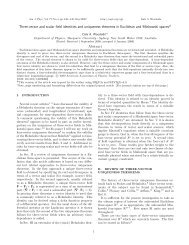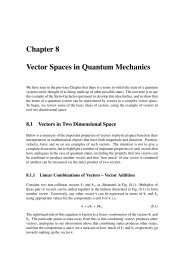Electrostatic Fields in Matter
Electrostatic Fields in Matter
Electrostatic Fields in Matter
Create successful ePaper yourself
Turn your PDF publications into a flip-book with our unique Google optimized e-Paper software.
12 SummaryThe state of a dielectric is characterised by three vector quantities:The electric field ⃗ EThe polarisation ⃗ P (= total dipole moment per unit volume).The displacement ⃗ D def<strong>in</strong>ed by ⃗ D = ɛ 0⃗ E + ⃗ P .There are relations between these quantities.⃗D = ɛ ⃗ E = ɛ r ɛ 0⃗ E and ⃗ P = ɛ0 χ e⃗ EThe polarisation gives rise to bound charges:σ b = ⃗ P · ˆn and ρ b = −∇ · ⃗PThe displacement D ⃗ is determ<strong>in</strong>ed by the free charges.∮∇ · ⃗D = ρ f (<strong>in</strong> <strong>in</strong>tegral form this is ⃗D · ⃗da = Q fenc )The field E ⃗ is determ<strong>in</strong>ed by ALL the charges (i.e.bound)free plusAt a dielectric boundary the normal component of ⃗ D and thetangential component of ⃗ E are cont<strong>in</strong>uous.The energy density <strong>in</strong> a polarised dielectric is 1 2 ⃗ D · ⃗E.17
















